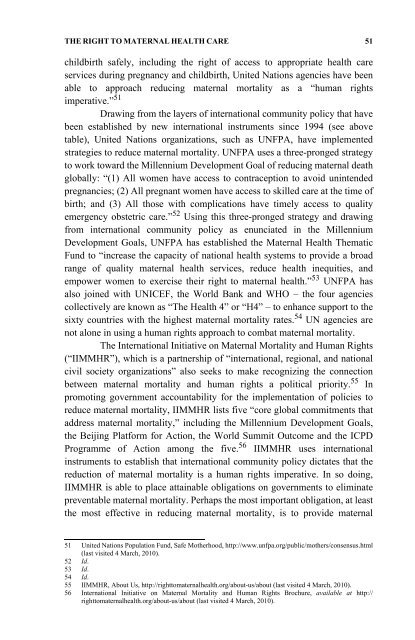University of Botswana Law Journal - PULP
University of Botswana Law Journal - PULP
University of Botswana Law Journal - PULP
Create successful ePaper yourself
Turn your PDF publications into a flip-book with our unique Google optimized e-Paper software.
THE RIGHT TO MATERNAL HEALTH CARE 51<br />
childbirth safely, including the right <strong>of</strong> access to appropriate health care<br />
services during pregnancy and childbirth, United Nations agencies have been<br />
able to approach reducing maternal mortality as a “human rights<br />
imperative.” 51<br />
Drawing from the layers <strong>of</strong> international community policy that have<br />
been established by new international instruments since 1994 (see above<br />
table), United Nations organizations, such as UNFPA, have implemented<br />
strategies to reduce maternal mortality. UNFPA uses a three-pronged strategy<br />
to work toward the Millennium Development Goal <strong>of</strong> reducing maternal death<br />
globally: “(1) All women have access to contraception to avoid unintended<br />
pregnancies; (2) All pregnant women have access to skilled care at the time <strong>of</strong><br />
birth; and (3) All those with complications have timely access to quality<br />
emergency obstetric care.” 52 Using this three-pronged strategy and drawing<br />
from international community policy as enunciated in the Millennium<br />
Development Goals, UNFPA has established the Maternal Health Thematic<br />
Fund to “increase the capacity <strong>of</strong> national health systems to provide a broad<br />
range <strong>of</strong> quality maternal health services, reduce health inequities, and<br />
empower women to exercise their right to maternal health.” 53 UNFPA has<br />
also joined with UNICEF, the World Bank and WHO – the four agencies<br />
collectively are known as “The Health 4” or “H4” – to enhance support to the<br />
sixty countries with the highest maternal mortality rates. 54 UN agencies are<br />
not alone in using a human rights approach to combat maternal mortality.<br />
The International Initiative on Maternal Mortality and Human Rights<br />
(“IIMMHR”), which is a partnership <strong>of</strong> “international, regional, and national<br />
civil society organizations” also seeks to make recognizing the connection<br />
between maternal mortality and human rights a political priority. 55 In<br />
promoting government accountability for the implementation <strong>of</strong> policies to<br />
reduce maternal mortality, IIMMHR lists five “core global commitments that<br />
address maternal mortality,” including the Millennium Development Goals,<br />
the Beijing Platform for Action, the World Summit Outcome and the ICPD<br />
Programme <strong>of</strong> Action among the five. 56 IIMMHR uses international<br />
instruments to establish that international community policy dictates that the<br />
reduction <strong>of</strong> maternal mortality is a human rights imperative. In so doing,<br />
IIMMHR is able to place attainable obligations on governments to eliminate<br />
preventable maternal mortality. Perhaps the most important obligation, at least<br />
the most effective in reducing maternal mortality, is to provide maternal<br />
51 United Nations Population Fund, Safe Motherhood, http://www.unfpa.org/public/mothers/consensus.html<br />
(last visited 4 March, 2010).<br />
52 Id.<br />
53 Id.<br />
54 Id.<br />
55 IIMMHR, About Us, http://righttomaternalhealth.org/about-us/about (last visited 4 March, 2010).<br />
56 International Initiative on Maternal Mortality and Human Rights Brochure, available at http://<br />
righttomaternalhealth.org/about-us/about (last visited 4 March, 2010).
















